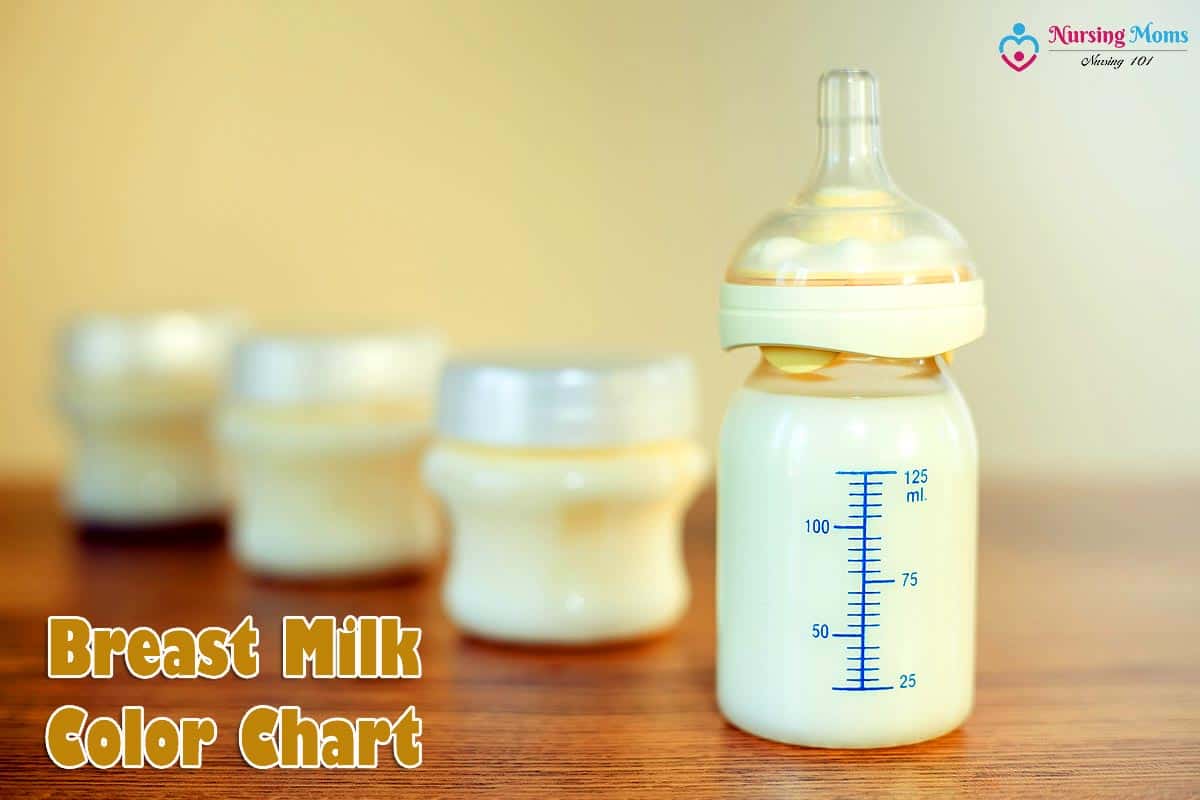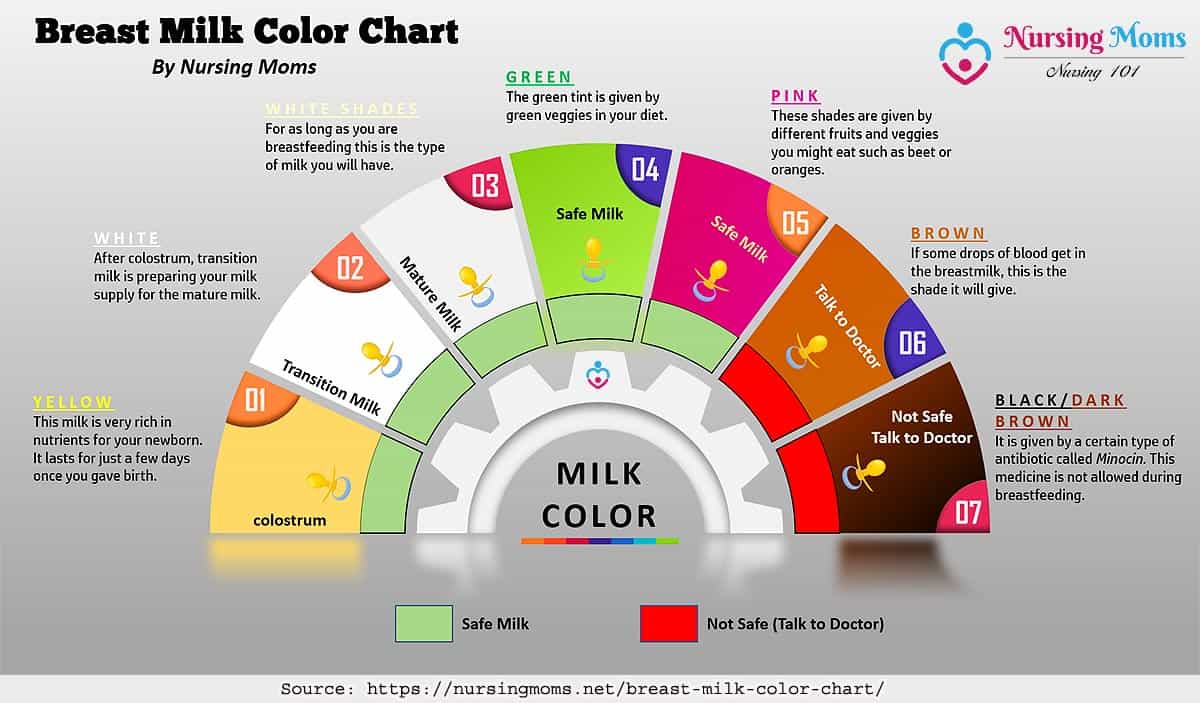
Breast Milk Color Chart: The color of your breast milk might be a concern, especially if you don’t have any experience when it comes to breastfeeding. New moms get alarmed easily when they notice a different tint in the color of the milk and start worrying about giving it to their baby or not.
The good news is that your breast milk will change colors in a natural way as well as under the impact of your diet.
Most such situations are no reason for concern. As long as you have all the information you need, you shouldn’t have to worry if you notice different colors in your breastmilk.
Table of Contents
Breast Milk Color Chart
Here are the different colors your breastmilk might have along the months and how to understand them!

Colostrums
Colostrum is the first breastmilk that comes shortly after giving birth.
- Usually, the color of this milk is yellow, but it can also be clearer and waterier.
- This is very rich milk in nutrients, and your baby will benefit a lot from it.
- It is very concentrated, but it will not last for a long time.

Transition Milk
The next milk that will come after the colostrums will be the transition milk.
- This transition milk will have a white color for around two weeks.
- It is a crucial period in which your body gets used to produce just the type of milk your baby needs.

Mature Milk
Your long term, regular milk will be the mature milk which comes right after the transition phase is over.
- The color of this milk depends on the quantity of fat it contains.
- It can be a firm white shade but also a little yellow or off-white color.
- All these options are normal.

Green Tinted Milk
If you notice that your milk comes in a shade of green, you might get worried.
- However, the truth is this tint could be caused by your diet or a specific medication you might be taking.
- If you eat a lot of green veggies (such as Spinach or Seaweed) and fruits, your breastmilk might achieve a green tint.
- This is nothing to worry about. Different vitamins such as chlorella that you might be taking can also change the color of your milk in green.
- Know that this is temporary and your breastmilk is perfectly fine for your baby.

Pink or Orange Milk
Another interesting color when it comes to breastmilk is a tint of orange, pink, or even red.
- This is also due to your diet (beets, carbonated soda or gelatin desserts) and the vitamins you might be on.
- Just like the green-tinted milk, this breastmilk will only have these shades temporarily.
- You have no reason for concern.

Brown/Rusted Shade Milk
You might be surprised to find out that some blood could get in the breastmilk as well.
- Naturally, this will alter the color of the milk and give it a rusted, brownish aspect.
- Cracked or bleeding nipples are a condition that could generate blood to enter your breastmilk as well. This is also known as “rusty pipe syndrome“. Talk to your doctor.
- If you are thinking of dumping your milk, don’t!.
- A little blood in the breast milk will not harm your baby at all.
- This shade will naturally disappear in a few days.
- If it doesn’t, and you are worried because of it, you might want to talk to your doctor.

Black/Dark Color Milk
Black or really dark color breastmilk is a rare situation, but it does happen.
- Mothers who take Minocin might have black-tinted breastmilk.
- Minocin or minocycline is a type of antibiotic, and it can also change the shade of your skin by making it darker as well.
- Minocin is not allowed while you are breastfeeding, so you shouldn’t take it at all.
But if for any reason you took it, contact your doctor immediately before breastfeeding your baby.

Breast Color Shades – A Comparison Table
| Yellow (colostrum) | This milk is very rich in nutrients for your newborn. It lasts for just a few days once you gave birth. | Yes, it is essential for your baby’s immune system. |
| White (Transition milk) | After colostrum, transition milk is preparing your milk supply for the mature milk. | Yes, it is very healthy for your baby. |
| Different shades of white (Mature milk) | For as long as you are breastfeeding, this is the type of milk you will have. | Yes, this is the type of milk your baby needs. |
| Green | The green tint is given by green veggies in your diet. | Yes, it is safe milk for your baby. |
| Pink or Orange | These shades are given by different fruits and veggies you might eat, such as beet or oranges. | Yes, it is safe to give it to your baby. |
| Brown or Rusted shades | If some drops of blood get in the breastmilk, this is the shade it will give. | As long as it is only a light shade of brown, you can use it. If you leak too much blood in your milk, talk to your doctor. |
| Black or Dark Brown | It is given by a specific type of antibiotic called Minocin. This medicine is not allowed during breastfeeding. | No. This milk is not safe for your baby! Talk to your doctor. |

So, in most cases, it is normal for your breastmilk to change colors. As a matter of fact, it is even natural for this to happen. But you shouldn’t hesitate to contact your doctor if you notice any drastic changes in your breastmilk.
If your breastmilk has an intense color that is far away from being white or yellow and it is more on the tint side, talking to your doctor might be a wise decision to stay on the safe side.
But otherwise, different tints are typical and nothing to be concerned about.

Key References
- “Colostrum”. Accessed January 03, 2020. Link.
- “Transitional Milk and Mature Milk – HealthyChildren.org”. Accessed January 03, 2020. Link.
- “The Phases of Breast Milk | WIC Breastfeeding”. Accessed January 03, 2020. Link.
- “Unusual appearances of breastmilk | Australian Breastfeeding Association”. Accessed January 03, 2020. Link.
- “The Color of Breast Milk and How It Changes”. Accessed January 03, 2020. Link.
- “Blood in Breast Milk: Is This Normal?”. Accessed January 03, 2020. Link.
- “Minocin” – WebMD. Accessed January 03, 2020. Link.


The article is very useful and have great information. Thanks for sharing such information!